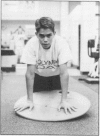Abstract
Proprioception following lower extremity injuries is commonly recommended, but there is little information on proprioception training following upper extremity injuries. No studies have evaluated whether proprioception programs for athletes in open kinetic chain activities (throwing, shot putting) should be different than programs for athletes in closed kinetic chain activities (gymnastics, swimming, kayaking, or rowing). In this paper, we provide a rationale for proprioception training for upper extremity injuries in athletes and the importance of analyzing the athlete's sport and activity for specificity of proprioception exercises. We then discuss one popular proprioception exercise, rhythmic stabilization, and propose several additional upper extremity proprioception exercises, along with instructions for the athletic trainer on how to direct the athlete through these exercises.
Full text
PDF



Images in this article
Selected References
These references are in PubMed. This may not be the complete list of references from this article.
- Brunt D., Andersen J. C., Huntsman B., Reinhert L. B., Thorell A. C., Sterling J. C. Postural responses to lateral perturbation in healthy subjects and ankle sprain patients. Med Sci Sports Exerc. 1992 Feb;24(2):171–176. [PubMed] [Google Scholar]
- Derscheid G. L., Brown W. C. Rehabilitation of the ankle. Clin Sports Med. 1985 Jul;4(3):527–544. [PubMed] [Google Scholar]
- Griffin J. W. Use of proprioceptive stimuli in therapeutic exercise. Phys Ther. 1974 Oct;54(10):1072–1079. doi: 10.1093/ptj/54.10.1072. [DOI] [PubMed] [Google Scholar]
- Janda D. H., Loubert P. Basic science and clinical application in the athlete's shoulder. A preventative program focusing on the glenohumeral joint. Clin Sports Med. 1991 Oct;10(4):955–971. [PubMed] [Google Scholar]
- Karlsson J., Andreasson G. O. The effect of external ankle support in chronic lateral ankle joint instability. An electromyographic study. Am J Sports Med. 1992 May-Jun;20(3):257–261. doi: 10.1177/036354659202000304. [DOI] [PubMed] [Google Scholar]
- Kennedy J. C., Alexander I. J., Hayes K. C. Nerve supply of the human knee and its functional importance. Am J Sports Med. 1982 Nov-Dec;10(6):329–335. doi: 10.1177/036354658201000601. [DOI] [PubMed] [Google Scholar]
- Markey K. L. Functional rehabilitation of the cruciate-deficient knee. Sports Med. 1991 Dec;12(6):407–417. doi: 10.2165/00007256-199112060-00006. [DOI] [PubMed] [Google Scholar]
- Markey K. L. Rehabilitation of the anterior cruciate deficient knee. Clin Sports Med. 1985 Jul;4(3):513–526. [PubMed] [Google Scholar]







